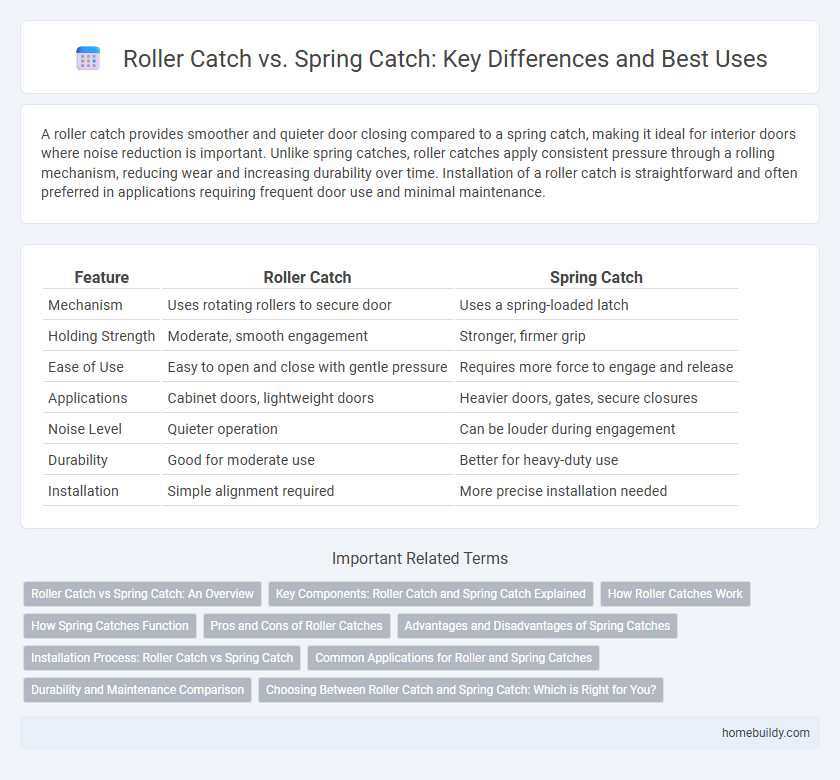A roller catch provides smoother and quieter door closing compared to a spring catch, making it ideal for interior doors where noise reduction is important. Unlike spring catches, roller catches apply consistent pressure through a rolling mechanism, reducing wear and increasing durability over time. Installation of a roller catch is straightforward and often preferred in applications requiring frequent door use and minimal maintenance.
Table of Comparison
| Feature | Roller Catch | Spring Catch |
|---|---|---|
| Mechanism | Uses rotating rollers to secure door | Uses a spring-loaded latch |
| Holding Strength | Moderate, smooth engagement | Stronger, firmer grip |
| Ease of Use | Easy to open and close with gentle pressure | Requires more force to engage and release |
| Applications | Cabinet doors, lightweight doors | Heavier doors, gates, secure closures |
| Noise Level | Quieter operation | Can be louder during engagement |
| Durability | Good for moderate use | Better for heavy-duty use |
| Installation | Simple alignment required | More precise installation needed |
Roller Catch vs Spring Catch: An Overview
Roller catches provide smooth and quiet operation by using rotating rollers to hold doors securely, offering superior durability and reduced wear compared to spring catches. Spring catches rely on a spring-loaded mechanism that can wear out faster and may produce noise during door operation, making them less ideal for high-traffic areas. Choosing between roller catch and spring catch depends on application requirements for noise reduction, longevity, and maintenance frequency.
Key Components: Roller Catch and Spring Catch Explained
The roller catch features a rotating cylindrical roller that engages a strike plate, offering smooth operation and adjustable tension for secure door closure. In contrast, the spring catch relies on a spring-loaded latch that snaps into a striker, providing firm holding power but less flexibility in tension adjustment. Both mechanisms serve as essential door hardware components, with roller catches favored for lighter doors and spring catches preferred for heavier, more robust applications.
How Roller Catches Work
Roller catches work by using a set of spring-loaded rollers that engage with a strike plate to secure doors or cabinets without the need for a traditional latch mechanism. The rollers compress when the door closes and then snap into a recess, providing smooth operation and consistent holding force, ideal for lightweight doors. Compared to spring catches, roller catches reduce noise and wear due to their rolling action and offer easier adjustment for door alignment.
How Spring Catches Function
Spring catches operate using a flexible spring mechanism that compresses and locks onto a mating component, providing a secure hold with consistent pressure. Unlike roller catches, which rely on rotating rollers to absorb and release force, spring catches use the elastic deformation of the spring to maintain tension and resist movement. This design offers smooth engagement, reliable retaining force, and simple installation for doors or panels requiring quick, controlled latching.
Pros and Cons of Roller Catches
Roller catches offer smooth, quiet operation and are ideal for lightweight doors, providing secure closure with minimal force. They tend to wear less quickly than spring catches, reducing maintenance needs, but can struggle with heavier doors or uneven frames due to limited holding power. While roller catches excel in ease of use and durability, they may lack the robust grip of spring catches in high-traffic or heavy-duty applications.
Advantages and Disadvantages of Spring Catches
Spring catches offer a secure grip with consistent tension, making them reliable for holding doors and panels firmly in place. They tend to be easier to install than roller catches and provide a quieter closing action without the rattling commonly associated with roller mechanisms. However, spring catches may wear out faster due to constant spring compression and can require more frequent maintenance to maintain optimal tension and functionality.
Installation Process: Roller Catch vs Spring Catch
The installation process of a roller catch involves aligning and mounting the roller mechanism on the door edge and the strike plate on the frame, requiring precise positioning to ensure smooth operation. In contrast, a spring catch requires fastening both the spring-loaded latch and corresponding strike plate, often accommodating slight misalignments due to its flexible spring tension. Roller catches generally demand more accurate installation to prevent door misalignment, while spring catches offer easier adjustment during fitting.
Common Applications for Roller and Spring Catches
Roller catches are commonly used in lightweight cabinet doors, closets, and furniture where smooth, quiet closing is essential, providing gentle holding power. Spring catches find frequent application in heavier doors, gates, and utility access panels, offering stronger retention through their spring-loaded mechanism. Both catches are preferred in residential and commercial settings based on door weight and the desired ease of operation.
Durability and Maintenance Comparison
Roller catches exhibit greater durability than spring catches due to their robust construction and reduced internal tension, resulting in less wear over time. Maintenance for roller catches is minimal since the rolling mechanism resists dirt buildup and requires infrequent lubrication compared to spring catches, which often need regular adjustment and replacement of worn springs. These factors make roller catches a more reliable choice for long-term applications where consistent performance and low upkeep are critical.
Choosing Between Roller Catch and Spring Catch: Which is Right for You?
Roller catches offer smooth, quiet operation and are ideal for lightweight doors or cabinets needing minimal latching force, while spring catches provide a stronger hold suitable for heavier doors requiring secure closure. Choosing between roller catch and spring catch depends on door weight, frequency of use, and desired latching strength. For applications prioritizing ease of use and noise reduction, roller catches are preferred; in contrast, spring catches are better for durability and firm door retention.
roller catch vs spring catch Infographic

 homebuildy.com
homebuildy.com